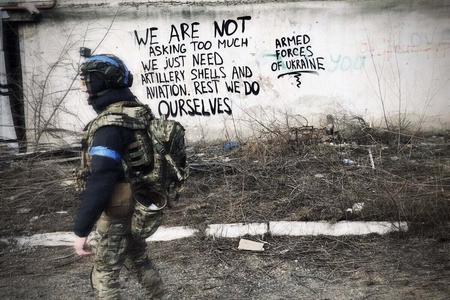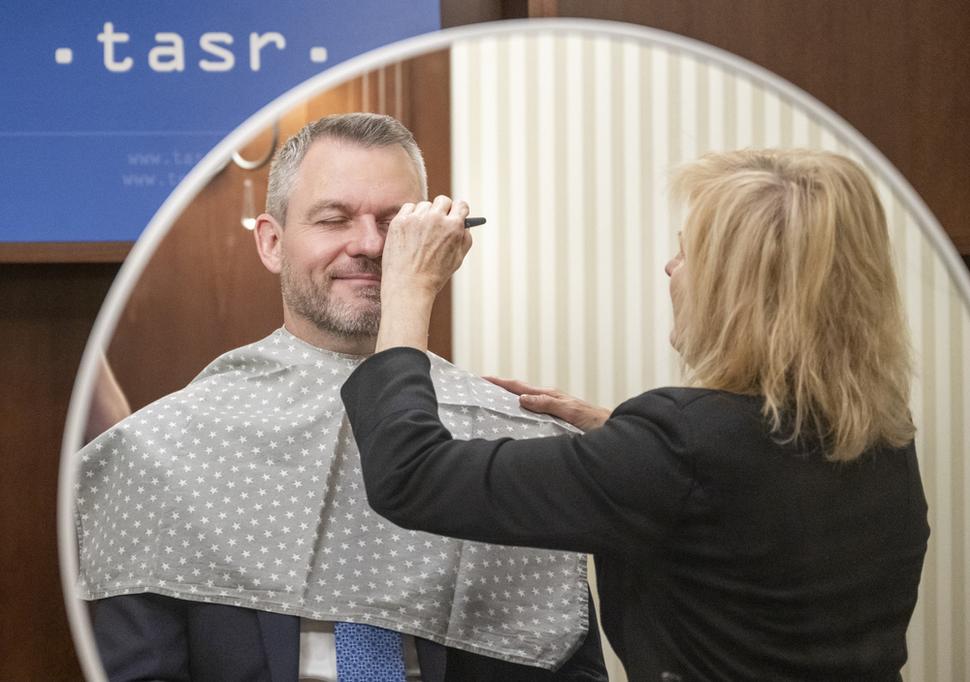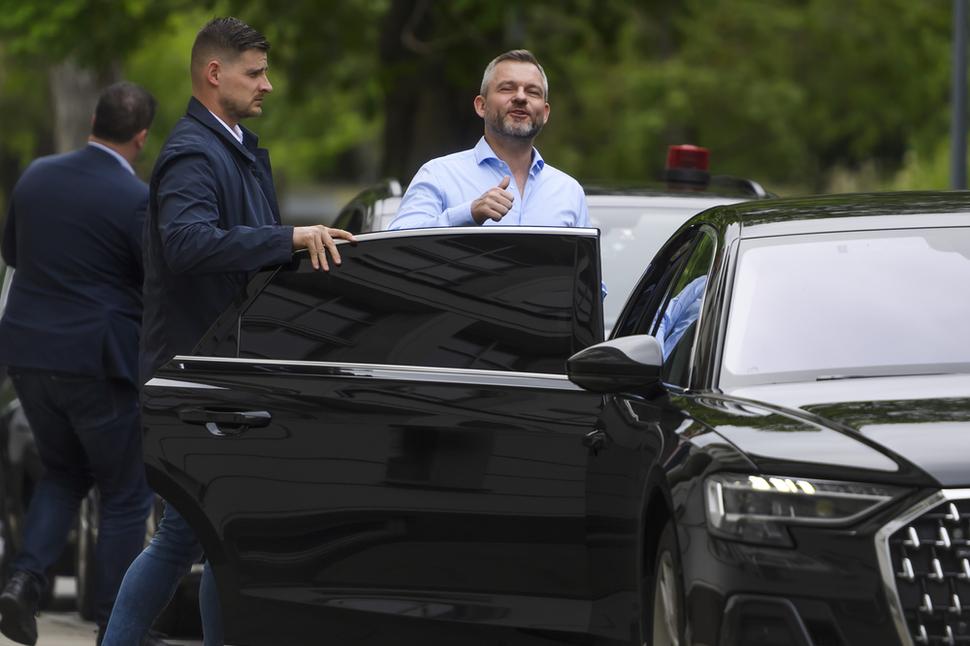This story was produced in partnership withReporting Democracy, a cross-border journalism platform run by the Balkan Investigative Reporting Network.
When Peter Pellegrini, freshly elected as president, got up on stage to address the media at midnight on election day, April 6, he was surrounded by many of his friends and allies. But two of the men gathered around him particularly caught the eye of observers.
Prime Minister Robert Fico, who helped Pellegrini – his coalition partner and former protégé – to win the race – in part thanks to a blizzard of falsehoods targeting his opponent, former diplomat Ivan Korčok – showed up at Pellegrini’s election night watch party shortly before midnight, once it was clear that Pellegrini would win. Their relationship had been said to be far from perfect, especially following Pellegrini’s 2020 decision to quit Fico’s party, Smer, after 20 years as a member, saying that he couldn’t imagine ever working in tandem with Fico again. The smiles, hugs and handshakes on election night, suggested that any differences have been quietly forgotten.
“You should be saying: ‘This is how it’s to be done. Damn it!’” a celebratory Fico declared, calling on the media to admit that Pellegrini’s achievement was also a vote of approval for his own government. The four-time premier added, triumphantly: “We’re predestined to rule until 2027.”
Pellegrini, who will turn 50 next year, lost the first round to Korčok after a low-key campaign. He’d relied on his visibility as speaker of parliament, and had apparently assumed that would be enough. After coming second to Korčok on 23 March, he launched a full-out attack on his opponent ahead of the second round, portraying him as the “president of war” and himself as the “president of peace”. These efforts paid off: his first round vote surged by almost 70 percent to reach 1.4 million, which was 150,000 more than Korčok received.
The other noteworthy man standing next to Pellegrini on election night was Slovakia’s only two-time former president (2004-2014), Ivan Gašparovič. Now aged 83 and also a former speaker of parliament, Gašparovič was, like Pellegrini, elected with the support of Smer.
“The president and the government will need our support,” Gašparovič told journalists at Pellegrini’s election victory party at the Aušpic Restaurant by the River Danube in Bratislava. In February, the ex-president said that he feels like he contributed to the creation of Fico’s fourth government.
Gašparovič, a one-time ally of Slovakia’s quasi-authoritarian 1990s leader Vladimír Mečiar, described himself, when in office, as an independent president. Yet he quickly grew into a staunch Smer ally. Pellegrini, who will be sworn in as Slovakia’s sixth president in June, pledged on election night not to be an “uncritical admirer” of Fico’s government.
But the president-elect also added, “The government, of which I’m a co-creator, doesn’t have to worry that an opposition power centre, which will take pleasure in the government’s failures, will emerge in the Presidential Palace, as has been the case for the past 10 years.”
At the same time, he said that his political party, Hlas, wouldn’t leave Fico’s ruling coalition, and would preserve its stability.
Gašparovič redux
After the election, many asked what kind of president Pellegrini would be, given his long history with Smer and Fico.
In a post-election column for the Sme daily titled “Slovakia elected Ivan Gašparovič”, veteran columnist Samuel Marec ventured to say that Pellegrini won’t be the president of people – as the Hlas leader is styling himself – but would instead turn into a second Gašparovič.
“He’ll be Fico’s president … he’ll be a servant with benefits,” Marec predicted.
Critics say Pellegrini has been unable to escape the shadow of his ex-party boss, who boasted a few years ago that he had made Pellegrini into who he is today. In recent months, the Hlas leader has shown little inclination to challenge Fico, especially when it came to the purges in the police, the abolition of the Special Prosecutor’s Office, and the radical changes to the Penal Code. Even on the occasions when he expressed some meek dissent – for example, Pellegrini said he would prefer not to bypass the president when it came to installing the coalition’s choice of new secret service chief – this quickly evaporated, and Pellegrini ended up backing Fico’s plans.
Pellegrini has even said that, as president, he won’t mind signing a bill, mimicking similar authoritarian measures in Hungary and Russia, that would force most NGOs to self-label as “foreign agents”. The measure is being proposed by the third party in the governing coalition, the far-right Slovak National Party (SNS), and represents another highly controversial item on the Fico administration’s to-do list.
Political analysts Miroslav Řádek, from Alexander Dubček University in Trenčín, and Grigorij Mesežnikov, from the Institute for Public Affairs think tank, also think that Pellegrini’s presidency will resemble Gašparovič’s rather than, say, President Michal Kováč, who was a notably independent-minded president.
“I’d be very surprised if Pellegrini cuts ties with his former friends and partners from politics and sets out on a solo ride,” Řádek told the Pravda daily.
Gašparovič, who once – in a recording from a private meeting with Smer MPs – compared himself to a member of Smer, barely objected to any of the actions of the Fico governments that ran the country during his time in office. This was a stark contrast to his obstructionism during the short-lived centre-right administration led by Iveta Radičová in 2010-2012.
He’s remembered as being the president who almost faced impeachment for refusing to appoint a duly elected general prosecutor, but also as someone who often mixed up words and names. By contrast, Kováč, the first Slovak president, who served from 1993 to 1998, stood up on several occasions to Mečiar in the 1990s.
Kováč, like Gašparovič, had once been a member of Mečiar’s party, the Movement for a Democratic Slovakia (HZDS). In a 1994 speech, he openly criticised Mečiar’s political style and ethics. A year later, Kováč’s son was kidnapped. Mečiar and the Slovak Information Service (SIS), the country’s main intelligence agency, are believed to have been behind the abduction, in the aftermath of which at least one person was murdered, but Mečiar later issued a series of amnesties foreclosing any investigation of the case. Despite the amnesties being overturned in 2017, the kidnapping case remains unresolved.
Pellegrini insists that he won’t work to Fico’s command.
“The support I received from people gives me the power to be a president who can speak his mind,” he said.
Still, some observers say he is unlikely to show much independence. Pellegrini was a significant part of Smer for two decades before he quit the party, and is thus jointly responsible for what Slovakia looks like today, they argue. In addition, he had a change of heart – one of many – and reunited with Fico to form the current coalition last year. According to Mesežnikov, there’s also a prosaic reason why Pellegrini needs to cooperate with Fico’s coalition: he may want to seek re-election in five years, for which he will need Smer’s support.
“For this reason, he will continue to do what Fico wants,” said Mesežnikov.
According to Řádek, Pellegrini might become “the new Michal Kováč” only if he discovers that Smer is likely to turn on him and that he risks being attacked by Fico again. When Pellegrini left Smer in 2020, Fico called him a “traitor”. The premier previously defamed former president and entrepreneur Andrej Kiska as a “usurer” and routinely maligns the incumbent, President Zuzana Čaputová, as an “American agent”, falsely implying that she represents the interests of other countries.
Ukraine-sceptic president
Fico and Pellegrini agree on the country’s foreign policy. They also share the same views towards Russia’s war in Ukraine.
Following his win in the election, foreign media described Pellegrini as “Ukraine-sceptic” and “pro-Russian”. In the campaign, Pellegrini called for peace, backed Fico’s refusal to supply ammunition to Ukraine from the stocks of the Slovak armed forces, and falsely claimed that his opponent would send Slovak soldiers to Ukraine.
However, Fico and Pellegrini haven’t opposed deals by Slovak arms companies to supply Ukraine on commercial terms.
“Aid, solidarity and peace,” the president-elect wrote on social media after a joint meeting between the Ukrainian and Slovak governments in eastern Slovakia on April 11.
Documents signed on that day don’t only talk about cross-border projects and help with mine clearing in Ukraine. They also suggest that the government’s position on Ukraine’s future in NATO, Ukraine’s territorial integrity and Zelensky’s peace plan, which the government had previously questioned but now supports, seems to have shifted.
In 2008, when Fico was in power, Gašparovič declared that Slovakia wants to see Ukraine in NATO.
When the Hospodárske Noviny daily asked former diplomat Rastislav Káčer about his past cooperation with Pellegrini, he said that it was “completely normal because under the previous governments, the official foreign policy was pro-European.” However, similar to Fico, Pellegrini has grown into a Eurosceptic. Pro-Russian Smer MP Marián Kéry described Pellegrini as someone who is “acceptable” to all parties.
“In the prime minister’s chair [2018-2020], he had meetings both in the White House and in the Kremlin,” the lawmaker said.
Pellegrini, who will be the first politician to have served as speaker of parliament, premier and president, will assume office on June 15.
A month later, he will attend his first NATO summit.

Hlas, poor Peter
Although Pellegrini – who, according to opinion polls is the most trusted politician in Slovakia – will soon become president, he hasn’t credibly explained how his non-transparent campaign was funded, how he managed to buy a €400,000 flat in downtown Bratislava, and if he pays for the use of a large villa and a private plane owned by Hlas MP Peter Náhlik. Reports surfaced in 2021 that Pellegrini had been accused by witnesses in a corruption case of accepting a €150,000 bribe in a champagne box from an oligarch, but he was never charged.
Apart from being a lifelong bachelor and talking a lot about his dog, Pellegrini says virtually nothing about his personal life.
One question that many observers have been asking is what will happen to his party, Hlas, once he no longer is its leader. Party officials insist that it will not re-merge with Smer, the party from which it split less than four years ago.
“I don’t have the slightest concern about the stability of Hlas,” Pellegrini said.
But political analyst Juraj Marušiak said that it’ll be harder to identify what Hlas stands for after Pellegrini departs as leader, adding that there is hardly any difference between Hlas and Smer, which both describe themselves as “social democratic”.
During its long existence Smer has swallowed up several other social democratic parties.
“Two parties that are almost exactly alike can hardly exist side by side, with one of them having a charismatic and easily identifiable leader and able to talk about ideological and political continuity, while the other party has none of that,” Marušiak concluded.


 President-elect Peter Pellegrini on election night (April 6) in Bratislava. Former president Ivan Gašparovič (l) stands next to him, as does Smer leader and PM Robert Fico. (source: SME - Marko Erd)
President-elect Peter Pellegrini on election night (April 6) in Bratislava. Former president Ivan Gašparovič (l) stands next to him, as does Smer leader and PM Robert Fico. (source: SME - Marko Erd)
 Peter Pellegrini gets ready for having his official portrait taken by a professional photographer on April 23, 2024. (source: TASR - Martin Baumann)
Peter Pellegrini gets ready for having his official portrait taken by a professional photographer on April 23, 2024. (source: TASR - Martin Baumann)
 Peter Pellegrini leaves the coalition council meeting on April 10, 2024 in Bratislava. (source: TASR - Jaroslav Novák)
Peter Pellegrini leaves the coalition council meeting on April 10, 2024 in Bratislava. (source: TASR - Jaroslav Novák)